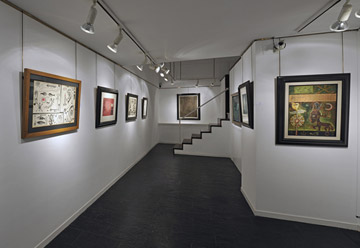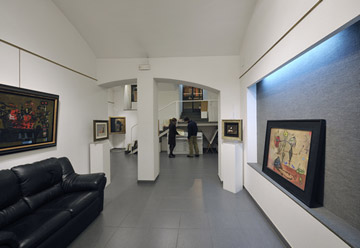- Amat, Frederic
- Amat, Gabriel
- Arranz Bravo
- Arroyo
- Barbara
- Barcelo
- Bartolozzi
- Bea
- Becquer
- Benet
- Bird
- Bores
- Brinkmann
- Brossa
- Cardenas
- Carral
- Casas
- Castillo
- Chancho
- Cisquella
- Clave
- Corbero
- Corneille
- Croft
- Cuixart
- Domingo
- Fabres
- Farreras
- Feito
- Fenosa
- Forteza
- Genovart
- Gimeno
- Gonzalez
- Gonzalo
- Graner
- Granyer
- Grau
- Grau Sala
- Gudiol
- Guinovart
- Hernandez Mompo
- Hernandez Pijuan
- Jorn, Asger
- Junyent, Oleguer
- Lam
- Llena
- Lloveras
- Lopez Ramon
- Marin
- Marsans
- Marsillach
- Marti Alsina
- Matilla
- Meifren
- Menchu Gal
- Meseguer
- Mir
- Mira
- Miro
- Moore
- Moragas
- Munoz
- Noland
- Olive
- Palazuelo
- Palencia
- Pazos
- Perejaume
- Perez Villalta
- Picasso
- Plantalech
- Plasencia
- Plensa
- Ponç
- Puig
- Rafols Casamada
- Ramis
- Rasero
- Rebull
- Riera i Arago
- Rivera
- Roca Sastre
- Roig
- Roig Soler
- Rossell
- Rueda
- Saura
- Serra
- Sicilia
- Solano
- Subirachs
- Sunyer
- Tamayo
- Tapies
- Tharrats
- Togores
- Torres Garcia
- Ubeda
- Ucles
- Valdes
- Valls
- Vedova
- Viladecans
- Vilagrasa
- Villa
- Zao Wou-ki
Artists +
Hours
Palencia
BIOGRAPHY OF BENJAMÍN PALENCIA (1894 - 1980):
Benjamín Palencia was born in 1894 in Barrax, Albacete, and passed away in 1980. At the age of 15, he moved to Madrid with the support of his uncle, Don Rafael López Egüez, who served as a kind of protector or patron. In Madrid, Palencia kept himself apart from official academic training, as it had little to do with his understanding of art. However, he frequently visited the Prado Museum to admire the works of Spanish painting masters such as El Greco, Velázquez, Zurbarán, and Goya.
Palencia became acquainted with numerous artists of the Spanish avant-garde, including Dalí, Alberti, and the poet Juan Ramón Jiménez, who became a significant supporter. He collaborated with Jiménez on multiple occasions, such as in the publication of the book "Niños." Palencia also traveled to France, where he met Picasso, Miró, Braque, Gargallo, and others.
Benjamín Palencia made his debut as an artist in 1925, participating in the Exhibition of the Iberian Artists Society at the Palacio del Retiro in Madrid, a crucial event for Spanish art in the first half of the 20th century. He achieved success and received favorable reviews from critics at this exhibition.
In his early years, Palencia explored surrealism and other avant-garde tendencies, evolving towards an austere realism combined with a colorful palette. During this period, he created still lifes and small cubist samples. This trend towards commercialization merged with the new realism, known as the "return to order." Gradually, his work matured, and he shifted his focus to Castilian landscapes.
Benjamín Palencia, along with sculptor Alberto Sánchez and several young artists and writers, founded the "Escuela de Vallecas," where he achieved a magnificent synthesis of tradition and avant-garde. Palencia played a crucial role in the resurgence of the Castilian landscape.
During the Spanish Civil War, he remained in Madrid and subsequently devoted himself to painting landscapes, initiating a second "Escuela de Vallecas" in 1942. Over time, his painting became more intense and powerful, with forms gaining greater volume, and he became more concerned with luminous aspects.
In the second significant phase of his life, Benjamín Palencia held numerous exhibitions in Spain and abroad. In 1974, he became a member of the Academy of Fine Arts of San Fernando, and a few years later, he joined the Academy of San Jorge in Barcelona.





